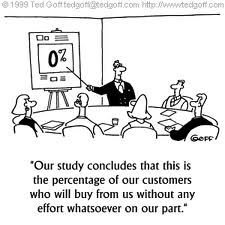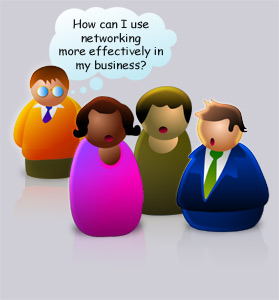 For some people selling comes easily and naturally. However for many business owners sales is a nuisance and although important, it’s something many people don’t want to do. Leave it to the professionals, is the motto and although if you have plenty of money in the bank to hire sales pro’s, it’s not for everyone.
For some people selling comes easily and naturally. However for many business owners sales is a nuisance and although important, it’s something many people don’t want to do. Leave it to the professionals, is the motto and although if you have plenty of money in the bank to hire sales pro’s, it’s not for everyone.
But sales doesn’t have to be that difficult. So, if you’re on your own, or working with a team of sales people that may under-perform, here are a few tips and tricks that could help your business to triple sales revenue by simply making it easier for you and your team to deal with potential new and old customers:
1. Use the number of averages – Many people put sales calls to one day a week or a specific time. Trying to do 20 or 30 or more calls to connect with potential clients may sound easy, but in reality how many did you actually get on the phone talking to? Most likely if you’ve done 20 calls you can consider yourself lucky if you talked to 3 – 5 prospects (and I mean getting to the main decision maker). This may sound good but reality is that it might even be less. Some weeks you may even just get to one or none. Turning this around is the key and making sure you make your calls on a more regular basis. Lets say you want to talk to 25 clients per week, divide them by 5 and now take 15 – 30 min each day to call 5 potential customers. You may still have days where you will not reach anybody of importance to you and you may need to add them to a different day/ time to call back. Once you get in to a rhythm however, you will notice that you transform 2 – 3 prospects on a daily basis (on average) either into meetings or sales (depending if you try to get a meeting or trying to get a sale over the phone).
2. Get yourself and/ or your team to go to networking events/ join networking groups. – This is important to spread the message of your business. You need to be out there and you need to be seen. Getting referrals is the goal with networking groups and getting meetings is the goal when you go to networking events. In both cases it is important to have the next step sorted before going/ joining:
3. Have a properly designed sales elevator pitch ready – With the right pitch you will gain up to 50% more referrals. Be specific, and tell people what or who it is that you’re looking for. A sales pitch is also great for networking events. It presents your business within 30 seconds, gives an overview of what it is that you do and how you can help any other business owner or potential customer to solve their problems. (If you need help creating an elevator pitch, you can contact us here).
4. Email/ letter marketing campaigns – Proper email or letter marketing campaigns are another great source to bring more customers to the table. But what’s important to know is that you need to do your research. If you don’t know who to address the letter/ email to, pick up the phone and ask. If you just send out generic emails to a list of thousands of customers, then you are not better than 95% of the other businesses doing just that. If you want to stand out and generate more revenue, you need to be different. Choose 100 of those potential clients, find out what they do, how you can help them and most importantly, who is your main contact and their contact details. Then address a properly designed letter/ email directly to them.
Don’t send all 100 sales letters on the same day. Spread them to maybe 5 – 10 letters daily. You will see why on point 5 and 6.
(If you need a sales elevator pitch and a powerful letter/ email marketing campaign, have a look at our PitchPerfect Programme here.)
5. Have an inactive and pro-active call to action in your letter/ email campaign. – An inactive call to action is when you ask your clients to give you a call based on the information they received and if they like it of course. This could be something simple such as: If you now, after reading this letter, can’t wait to talk to me, please give me a call on xxx xxx xxxx or please fill in this application form and return back to us.
A pro-active call to action is when you take matters in your own hands. This is usually followed by the inactive call to action and is a simple way of saying, I will be calling you. You could say after your inactive call to action: If however you are like most business owners very busy running your business and may not have the time to call us, then don’t worry. I will call you on date x to discuss this in more detail with you. Our call will not take longer than 2 – 3 min of your valuable time. (make sure that with an email campaign you allow 48 hours before you call, on a letter campaign between 3 – 5 days. Don’t take longer. If you give them 2 weeks they will not remember your letter or you for that matter.
Now it’s your move. You promised a call on that specific day and most people do expect your call. Make sure you keep this in your diary and make that call.
6. Follow-up – It doesn’t matter if you take my advise on point 5 and have both an in-active and pro-active call to action or not. If you don’t follow up with your prospects, no one will. The return rate is usually quite low but if you keep your focus and make those follow-up calls, you will gain better results than any other company that sends generic emails/ letters. In fact, we have measured the success rate with a number of companies that we’ve worked with and it’s anywhere between 30 – 45%. Just by simply picking up the phone and making those dreaded phone calls. The good news is, that if you send a letter or email before hand, it’s no longer considered a cold call. It may not be a hot call, but luke-warm is already good.
7. Ask for referrals – Be it with your networking group or with customers and other business owners that you simply use for referrals, asking for referrals is the best way to keep your business growing. If you prepare your clients that you will be looking for referrals as part of your payment, then they will expect if they sign a contract with you, that you will be looking for referrals from them. Some clients may not be comfortable with it and others may just give you one or 2. On average we found that per client you could gain anything from 2 – 3 referrals that will help you keep going with your business.
When in a referral or networking group, it is important that you have a properly designed sales elevator pitch but also that you ask for specific referrals. Don’t be generic like: I’m looking for medium sized companies who are interested in xyz. You will not gain much out of that one. However if you ask specific it will make a difference: I’m looking for medium sized printing companies in area x. (If you can and done your homework you could also add:) I’m looking for an introduction to company X-Print in Town Y and company W-Print in Town Z. The only danger here is that if you choose 2 companies, it might happen that no one in your networking group knows anybody in those companies. However, consistency is the key and asking every week (or every time you meet with your group) for other specific companies, then you will get more referrals out of this. You could also ask type specific such as medium sized IT companies with focus on cloud computing or Start ups, Management consultancies, Coaching businesses etc. Be specific and referrals will come.
8. Put a picture of yourself on your business card and letter/ email campaign – People like dealing with people and this simple change can help you gain at least 10 – 15% more traction. People will remember you, they might not remember your business but they will most certainly remember you. If it’s in a good or bad way is of course up to you and your own selling skills but most people will remember your face.
Sales doesn’t have to be a daunting exercise. If you take every day 30 min to 1 hour to connect with new and old customers, you should see an improvement within a very short period of time in your sales revenue.
Some people say, sales is a numbers game, others say it’s not. In fact, sales is a game of averages. Every day you should do some sales related activity (and by that I mean not looking at your facebook page and hoping to get a customer interact with you). I mean real sales activity when you actively look for new potential customers, engage with old or former clients, use proper up-selling and cross-selling techniques and become more and more visible. Be out there, go to networking events, sign up to a networking group, join the chamber of commerce and actively promote yourself first, then your business and you will see a rise in sales revenue. Meet for networking coffees to discuss how you can help each other.
Try out different ways to interact with your customers. If you have a list of old or former clients, talk to them again. Maybe you have some missed up- or cross-sell opportunities, maybe you can get some referrals out of them. If your old clients are happy, they are more willing to recommend you on to somebody they do business with.
Have the right steps in place when it comes to your own sales strategy. If you don’t have one, it’s time to create one. Make it your daily mantra to work at least 1 hour on your sales and your business will flourish. (Just for the people who might say, 1 hour is not enough…we found in our research that the average time spend on sales activity is less than 2 hours per week for most SME’s. Having a focused 1 hour per day will not only enhance the performance of the business but will make it much easier to grow this activity over time to a decent 2 – 3 hours per day. Some SME owners are not able to spend that much time only on sales activity as they are out working with customers. Getting them to spend 1 hour per day on this, is the real challenge).
Follow us on Facebook and Twitter for more up to date information.
Carsten
Carsten Schnier is the founder of SalesClinic & Coach Clinic and professional sales consultant based in Cork, Ireland. Creating a synergy between consultation, training and coaching helps our clients to achieve the best results.









